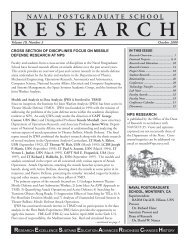Spectral Unmixing Applied to Desert Soils for the - Naval ...
Spectral Unmixing Applied to Desert Soils for the - Naval ...
Spectral Unmixing Applied to Desert Soils for the - Naval ...
You also want an ePaper? Increase the reach of your titles
YUMPU automatically turns print PDFs into web optimized ePapers that Google loves.
wavelengths being analyzed <strong>to</strong> obtain <strong>the</strong> estimation per pixel. Two channels are used,<br />
an absorption set centered on 1130 nm (a water band) and a reference set taken from<br />
beside <strong>the</strong> water band, in conjunction with a look up table constructed <strong>to</strong> look up <strong>the</strong><br />
water vapor values (Bernstein et al., 2012).<br />
Once <strong>the</strong> water vapor calculation has been completed, Equation (3) must<br />
<strong>the</strong>n be solved <strong>to</strong> get pixel surface reflectance <strong>for</strong> all of <strong>the</strong> sensor channels. The<br />
calculation computes a spatially averaged radiance image Le, which is how ρe is<br />
estimated. The following equation is used <strong>to</strong> calculate Le.<br />
The averaging is conducted using a point-spread function describing relative<br />
contributions of points on <strong>the</strong> ground <strong>to</strong> pixel radiance after cloudy pixels have been<br />
removed. The ground points are measured at different distances relative <strong>to</strong> <strong>the</strong> direct line<br />
of sight (Bernstein et al., 2012). Aerosol and haze estimation in <strong>the</strong> FLAASH model is<br />
done using dark land pixels in <strong>the</strong> imagery. The aerosol/haze amount is obtained by<br />
running multiple iterations of Equations (3) and (4) over several visible ranges (say 12–<br />
50 Km) and <strong>the</strong>n interpolating <strong>the</strong> best estimate of <strong>the</strong> visible range through matching<br />
that ratio <strong>to</strong> an average ratio of ~0.45. MODTRAN4 calculates a final loop over water<br />
using this visible range estimation (Bernstein et al., 2012).<br />
In order <strong>for</strong> <strong>the</strong> FLAASH atmospheric processing <strong>to</strong> be conducted in<strong>for</strong>mation<br />
had <strong>to</strong> be obtained in <strong>the</strong> <strong>for</strong>m of gain files and flight parameters from <strong>the</strong> JPL website<br />
(http://aviris.jpl.nasa.gov/alt_loca<strong>to</strong>r/). These files come as part of <strong>the</strong> imagery zip files<br />
though one must go through <strong>the</strong>m <strong>to</strong> obtain <strong>the</strong> required data. This includes in<strong>for</strong>mation<br />
on <strong>the</strong> elevation of <strong>the</strong> sensor, average scene elevation, time and date of acquisition, and<br />
<strong>the</strong> latitude/longitude position of <strong>the</strong> scene center. Figures 17 A and B show <strong>the</strong><br />
spectrum corresponding <strong>to</strong> latitude 37 57'43.92"N, -109 47' 46.03"W of <strong>the</strong> June 23<br />
Canyonlands data set (f110623t01p00r10rdn). Noise-containing bands related <strong>to</strong> water<br />
vapor were removed at wavelengths near 1.4 and 1.9 micrometers by editing <strong>the</strong> bad<br />
bands list of <strong>the</strong> header file.<br />
36<br />
(4)
















